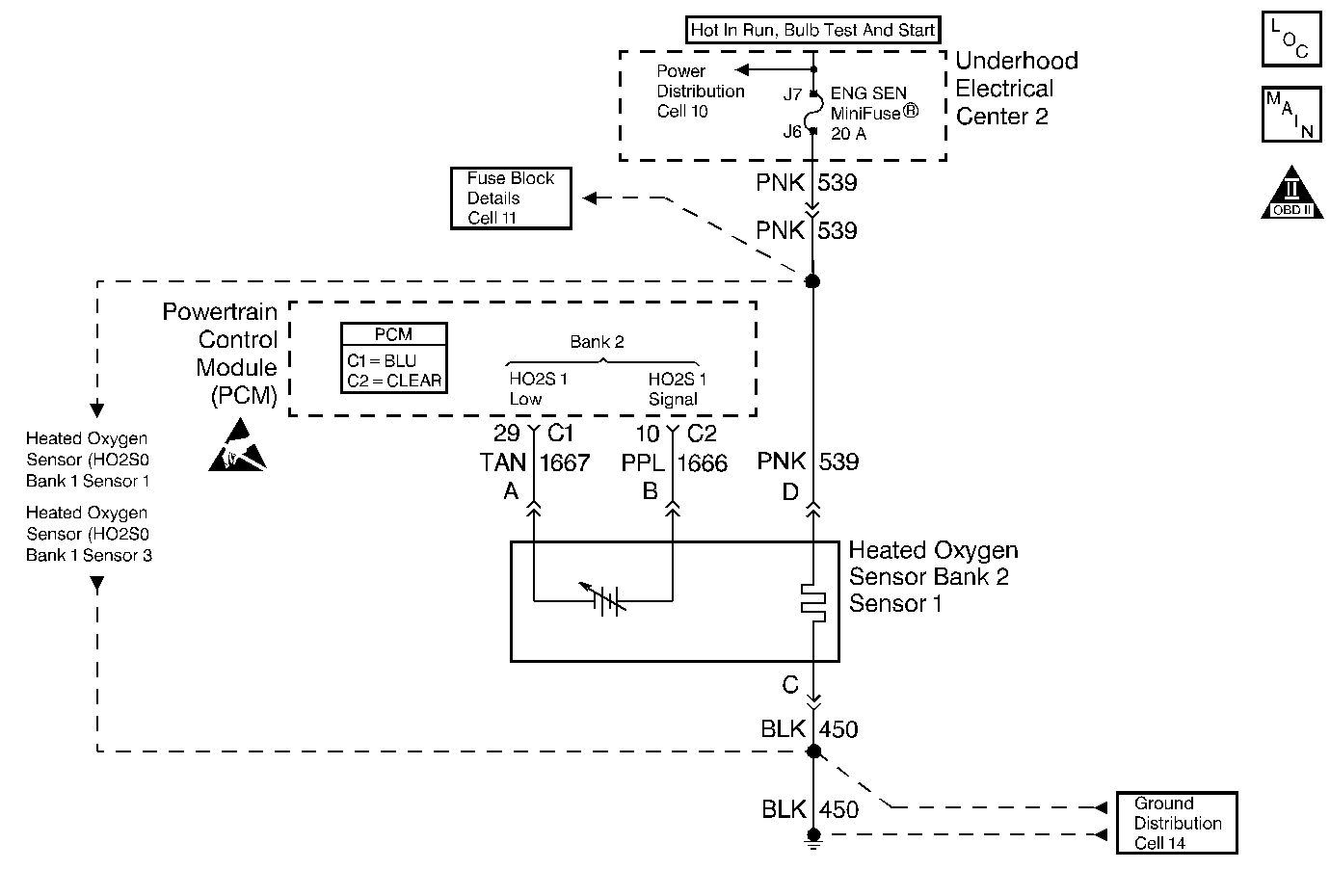
Circuit Description
The PCM continuously monitors the Heated Oxygen Sensor (HO2S) activity. The PCM counts the number of times that the a rich to lean and lean to rich response is indicated and adds the amount of time it took to complete all transitions for a 100 second test period. With this information, an average time for each transition can be determined. If the average response time is too slow, a DTC P0153 will be set. A lean to rich transition is indicated when the HO2S voltage changes from less than 300 mV to greater than 600 mV. A rich to lean transition is indicated when the HO2S voltage changes from more than 600 mV to less than 300 mV. An HO2S that responds too slowly is likely to be faulty and should be replaced.
Conditions for Running the DTC
| • | No Misfire, CKP, Fuel Injector, MAF, TP, EVAP, IAT, MAP or Fuel Trim DTCs are set. |
| • | Engine has been running in closed loop for at least 1 minute. |
| • | Engine speed is between 1000 RPM and 3000 RPM. |
| • | Engine Coolant Temperature is greater than 50°C (122°F). |
| • | Mass Air Flow values are between 13 and 30 gps. |
Conditions for Setting the DTC
| • | Bank 2 H02S 1 lean to rich and rich to lean average transition response time is longer than 150 milliseconds. |
| • | The test only runs once per key cycle. |
Action Taken When the DTC Sets
| • | The PCM will illuminate the malfunction indicator lamp (MIL) during the second consecutive trip in which the diagnostic test has been run and failed. |
| • | The PCM will store conditions which were present when the DTC set as Freeze Frame and Failure Records data. |
Conditions for Clearing the MIL/DTC
| • | The PCM will turn OFF the MIL during the third consecutive trip in which the diagnostic has been run and passed. |
| • | The History DTC will clear after 40 consecutive warm-up cycles have occurred without a malfunction. |
| • | The DTC can be cleared by using the scan tool. |
Diagnostic Aids
Check for the following conditions:
| • | Poor connection at the PCM - Inspect harness connectors for the following conditions: |
| - | Backed out terminals. |
| - | Improper mating. |
| - | Broken locks. |
| - | Improperly formed or damaged terminals. |
| - | Poor terminal to wire connection. |
| • | Damaged harness - Inspect the wiring harness for damage. If the harness appears to be OK, observe the Bank 2 HO2S 1 display on the scan tool while moving connectors and wiring harnesses related to the sensor. A change in the display will indicate the location of the fault. |
Review the Freeze Frame/Fail Records vehicle mileage since the diagnostic test last failed. This may help determine how often the condition that caused the DTC to be set occurs.
Test Description
Number(s) below refer to the step number(s) on the Diagnostic Table:
-
This step verifies that the fault is currently present.
-
HO2S transition time, ratio mean volts and switching DTCs set for multiple sensors indicate probable contamination. Before replacing the sensors, isolate and correct the source of the contamination to avoid damaging the replacement sensors.
Step | Action | Value(s) | Yes | No | ||||||
|---|---|---|---|---|---|---|---|---|---|---|
1 | Did you perform the Powertrain On-Board Diagnostic (OBD) System Check performed? | -- | ||||||||
|
Important: If any DTCs are set, (except other HO2S DTCs), refer to those DTCs before proceeding with this table.
Does scan tool indicate this DTC failed this ignition? | -- | Go to Diagnostic Aids | ||||||||
Did the scan tool also indicate other HO2S DTCs test failed this ignition? | -- | |||||||||
4 | Inspect the exhaust system for a leak. Did you find and correct the condition? | -- | ||||||||
5 | Visually/physically inspect the following items:
Was a problem found? | -- | ||||||||
6 |
Does the scan tool indicate HO2S voltage near the specified value? | 450 mV | ||||||||
7 |
Does scan tool indicate HO2S voltage less than the specified value? | 300 mV | ||||||||
8 | Replace affected Heated Oxygen Sensors. Refer to Heated Oxygen Sensor Replacement . Important: Before replacing sensors, the cause of the contamination must be determined and corrected.
Did you complete the repair? | -- | -- | |||||||
9 | Repair the condition as necessary. Refer to Intermittents and Poor Connections Diagnosis and Connector Repairs or Wiring Repairs . Did you complete the repair? | -- | -- | |||||||
10 | Repair an open HO2S low circuit or a short to ground in the HO2S signal circuit. Refer to Wiring Repairs . Did you complete the repair? | -- | -- | |||||||
11 | Repair an open HO2S signal circuit or faulty PCM connections. Refer to Intermittents and Poor Connections Diagnosis and Connector Repairs or Wiring Repairs . Did you complete the repair? | -- | -- | |||||||
12 | Replace the HO2S. Refer to Heated Oxygen Sensor Replacement . Did you complete the replacement? | -- | -- | |||||||
13 |
Does the DTC reset? | -- | System OK |
